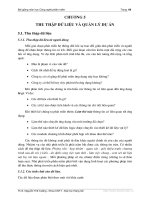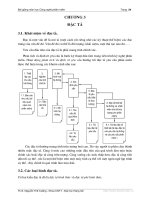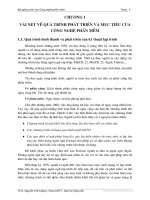Bài giảng công nghệ vắc xin - Chương 4: Cơ sở miễn dịch học
Bạn đang xem bản rút gọn của tài liệu. Xem và tải ngay bản đầy đủ của tài liệu tại đây (8.93 MB, 108 trang )
CÔNG NGHỆ VẮC XIN
CÔNG NGHỆ VẮC XIN
CHƯƠNG IV
CƠ SỞ MIỄN DỊCH HỌC•
Miễn dịch (immunity) là trạng thái đề kháng với bệnh tật, đặc biệt là
các bệnh nhiễm trùng.
•
Hệ thống miễn dịch là tập hợp các tế bào, mô và các phân tử
tham gia vào quá trình đề kháng chống nhiễm trùng.
•
Đáp ứng miễn dịch là phản ứng có sự phối hợp của các tế bào và
phân tử thành phần của hệ thống miễn dịch lách
Tuỷ xương
Tuyến ức
Hạch lympho•
Description of the contents
•
Description of the contents
•
Hoạt động của đại thực bào được tăng cường nhờ
kháng thể và bổ thể thông qua hiện tượng opsonin hóa
gxj
Hàng rào vật lý
Da và niêm mạc
•
Tế bào NK ly giải tế bào nhiễm
Viêm -sốt
Hệ thống bổ thể
Các tế bào làm
nhiệm vụ thực
bào
•
Interferon
Kiểm soát sớm
nhiễm trùng
•
Các tế bào bạch cầu, đại thực bào, tế bào nhiễm
virus hoạt hóa phóng thích Interferon
Tấn công và phá vỡ màng tế bào, kích thích viêm,
tham gia thực bào
Phản ứng sốt có tác dụng ngăn chặn sự nhân lên
của virus.
Hắt hơi ( triệu chứng dị ứng)
•
Hệ hô hâp: ở động vật có vú, hệ hô hấp hoạt động rất có
hiệu quả theo các cơ chế khác nhau.
Vi sinh vật cùng bụi bậm theo dòng khí vào cơ thể khi ta
hít thở.
Các hạt lớn (>10μm) đều bị chặn lại ở khoang muĩ nhờ
đám lông dày đặc.
•
Các hạt nhỏ (<10μm) tiến sâu vào họng, tại đây chúng bị
lớp lông nhỏ bao phủ màng nhầy quạt hất ra ngoài. *
Chất nhầy ẩm và dính cũng bẫy vi sinh vật vào khoang
miệng rồi theo phản xạ khạc ra ngoài hoặc nuốt vào dạ
dày rồi ra ngoài theo phân
•
Physical and Chemical Barriers (Innate Immunity)
•
Physical and chemical barriers form the first line of defense when your body is
invaded.
•
Physical Barriers
•
Your skin has thick layer of dead cells in the epidermis which provide protection
•
Your mucous membranes trap microbes.
•
Chemical Barriers
•
Lysozyme, an enzyme produced in tears, acts as an antibiotic (kills bacteria)
•
Gastric juice in the stomach destroys bacteria because the gastric juice is
highly acidic (pH 2-3).
•
Nonspecific Resistance (Innate Immunity)
•
The second line of defense is nonspecific resistance that destroys invaders in
a generalized way without targeting specific individuals:
•
Phagocytic cells ingest and destroy all microbes that pass into body tissues.
For example macrophages are cells derived from monocytes (a type of white
blood cell). Macrophages leave the bloodstream and enter body tissues to patrol
for pathogens. When the macrophage encounters a microbe, this is what
happens:
–
The microbe attaches to the phagocyte.
–
The phagocyte's plasma membrane extends and surrounds the microbe and
takes the microbe into the cell in a vesicle.
–
The vesicle merges with a lysosome, which contains digestive enzymes.
–
The digestive enzymes begin to break down the microbe. The phagocyte
uses any nutrients it can and leaves the rest as indigestible material and
antigenic fragments within the vesicle.
–
The phagocyte makes protein markers, and they enter the vesicle.
–
The indigestible material is removed by exocytosis.
–
The antigenic fragments bind to the protein marker and are displayed on the
plasma membrane surface. The macrophage then secretes interleukin-1
which activates the T cells to secrete interleukin 2, as described below
under specific resistance .
•
Inflammation is a localized tissue response that occurs when your tissues are
damaged and in response to other stimuli. Inflammation brings more white blood
cells to the site where the microbes have invaded. The inflammatory response
produces swelling, redness, heat, pain
•
Fever inhibits bacterial growth and increases the rate of tissue repair during an
infection.
virus
Miễn dịch trung gian tế bào
Tế bào T độc
Tế bào T độc
tiếp xúc tế
bào nhiễm
Tế bào nhiễm
MHC+ KN
virus
Tế bào
nhiễm
bị ly
hgiải
virus
Kháng thể bao
quanh virus
Kháng thể
Virus
không thể
gây nhiễm
tế bào chủ
Virus bị
giết bởi
bạch cầu
trung tính
Tế bào bạch cầu trung tính
Tế bào chủ
• Miễn dịch không đặc hiệu
• Miễn dịch đặc hiệu
• Kháng nguyên
• Kháng thể
•
Cơ quan và tế bào tham gia vào hệ thống miễn dịch
•
Thụ thể tế bào T
•
Kháng nguyên phù hợp mô
•
Bổ thể
•
Quá mẫn









